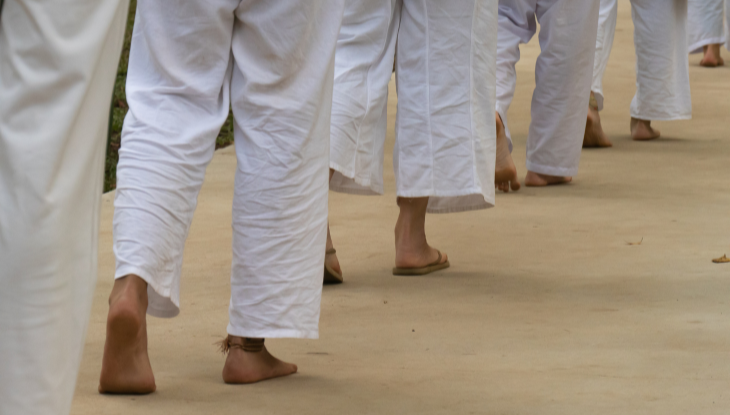Walking meditation is a practice that combines physical movement with deep awareness. It is a form of mindfulness meditation that allows for achieving a state of mindfulness without the need to sit in silence.
In this article, you will learn how to prepare for walking meditation, what its basic principles and techniques are. We will also address the benefits of regular practice. We will share practical tips to help you incorporate into your life.
What is walk meditation?
Walking meditation is a method that combines mindfulness meditation with slow, conscious walking along a designated path. It is a way to practice meditation in motion, with walking becoming the focal point. This allows for easier attention to be paid to the body sensations while moving step by step. This practice enables one to maintain awareness in the present moment.
In some Buddhist traditions, such as the Japanese Zen tradition, walking meditation known as kinhin is seen as a complement to sitting meditation. It is particularly recommended after a long period of sitting in meditation. Thich Nhat Hanh, an influential Buddhist teacher, emphasized the role of walking meditation outdoors as an important practice of mindfulness. He claimed that it is essential for a deeper connection with the environment. He described it as walking in a way to be aware of every step.
Is accessible to everyone, regardless of beliefs. Developing mindfulness skills through conscious walking brings benefits both physically and mentally, greater than in the case of separate walking or meditation practices.
Benefits of walking meditation
Improves balance. It can also help with better sleep. Reduces stress and anxiety. Helps in managing mild to moderate depressions. It can suppress thoughts that drive emotional disturbances. It brings a general sense of calm and well-being. As a gentle form of physical exercise, it improves circulation and promotes fat tissue reduction.
A meditative walk in nature can significantly improve mood and life perspective. As a mindfulness practice, it enhances focus and concentration. When you feel too agitated to sit and meditate, walking meditation can help dispel anxiety. It calms the mind and restores inner balance.

Walking meditation – how to practice step by step
Is a unique practice that combines movement with deep concentration, allowing for the attainment of mindfulness while in motion. To begin, it is crucial to find a suitable place that will provide peace and help avoid distractions. An ideal location would be a quiet part of the park, away from the hustle and bustle of the city. It is important that the path chosen allows for full focus on the body and breath, as well as on the surroundings, which can enhance the meditative experience.
Traditionally, walking meditation is done on a designated, safe path, often in the form of simple lines. Where one can focus on each step and breath without hindrance, repeating the route back and forth. Some practitioners also choose labyrinths as a place of meditation, allowing for deeper contemplation and focus. Regardless of the path, it is important for the attire to be comfortable and suitable for the conditions, enabling full engagement in the practice without unnecessary distractions.
During walking meditation, the focus is directed towards the sensations coming from the body. By synchronising movements with the breath, it allows for deeper mindfulness and presence in the moment. This practice is particularly recommended as a complement to seated meditation, helping to disperse accumulated energy and restore inner balance. Regardless of experience in meditation, walking mindfully is accessible to everyone, offering both physical and mental benefits. Such as improved balance, better sleep, stress reduction, as well as promoting an overall sense of peace and well-being.
How to deal with doubts?
Many people starting the practice of walking meditation often ask themselves, “Am I doing this right?”. It’s completely normal, but it’s crucial not to dwell too much on this doubt. What’s important is the approach and intention of being present in the moment – if you are achieving that, it means you are meditating correctly.
When worries or doubts arise, it is important to remind yourself that learning a new skill takes time and patience. Getting lost in thoughts during walking meditation is not a bad thing. It is important to gently bring your awareness back to the present moment. When in doubt, focusing on the five senses: sight, smell, taste, hearing, and touch can be helpful. Try not to criticize yourself when your thoughts start to wander.
Walking meditation or traditional meditation – which one to choose?
Walking meditation and traditional sitting meditation are two sides of the same coin, aimed at cultivating mindfulness and presence. Although both forms aim for the same goal, they offer completely different experiences, tailored to the needs and preferences of practitioners. Sitting meditation invites deep peace and introspection, encouraging immersion in the inner world and focusing on the breath. It is a time when one can completely pause and dedicate a moment to self-observation.
On the other hand, walking meditation introduces an element of movement, transforming the everyday activity of walking into an act of mindful practice. Here, movement becomes an anchor of mindfulness, and the surroundings – both urban and rural – become part of the meditative experience. This form of meditation is particularly useful for individuals leading active lifestyles and looking for ways to incorporate mindfulness practice into movement. Walking meditation not only energises the body and stimulates circulation but also allows for a deeper connection with the surrounding world.
Both walking and sitting meditation practices can complement each other, offering a comprehensive approach to meditation. Incorporating both into your daily routine can bring new perspectives and help maintain the freshness of your practice. With their diversity, everyone can find something that suits them. Whether it’s a moment of calm during the day or the opportunity for mindful movement when we need a more dynamic form of mindfulness.
